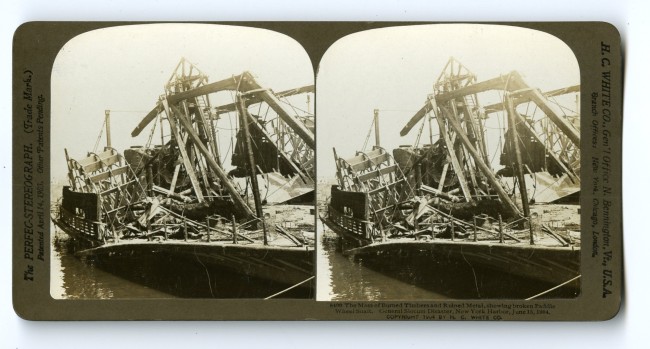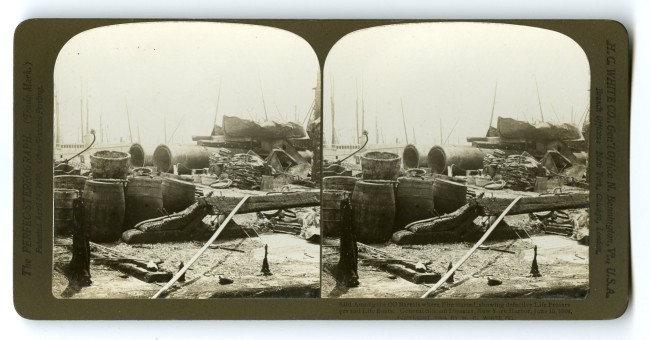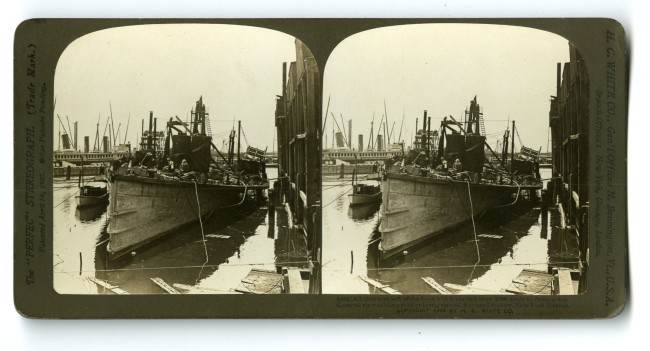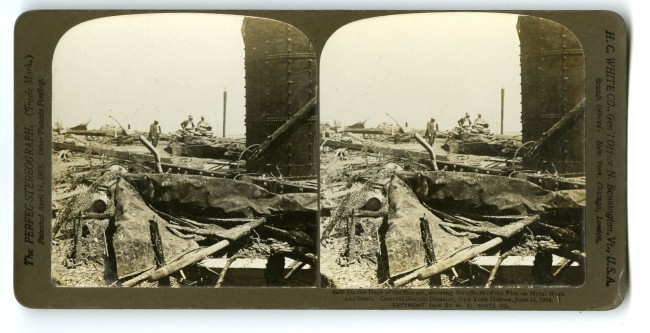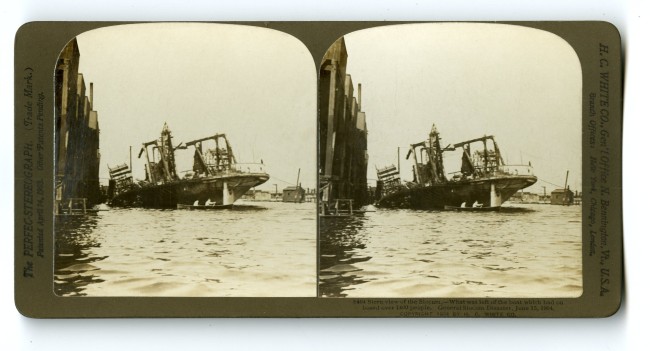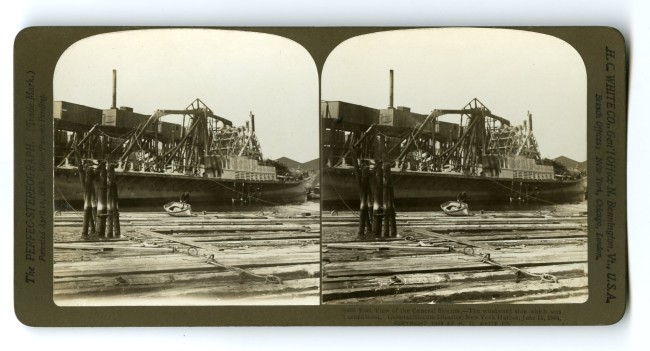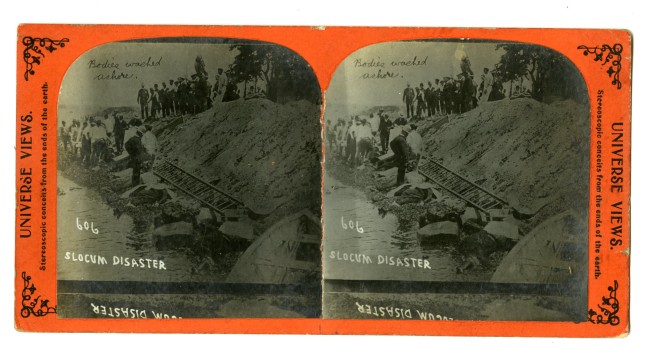The General Slocum Disaster, NY Harbor, 1904
by William Kornblum; minor edits by Jeffrey Kraus
With slight modification, the text is excerpted from: AT SEA IN THE CITY: New York from the Water’s Edge by William Kornblum. © 2002 by William Kornblum. Reprinted by permission of Algonquin Books of Chapel Hill. All rights reserved.
Images from the Jeffrey Kraus Collection.
The burning of the General Slocum resulted in banner headlines across the New York Times edition of June 16, 1904:
1,000 LIVES MAY BE LOST IN BURNING OF
THE EXCURSION BOAT GEN. SLOCUM
—
St. Mark’s Church Excursion Ends in Disaster in East River
Close to Land and Safety.
—
693 BODIES FOUND — HUNDREDS MISSING OR INJURED
—
Flames Following Explosion Drive Scores to Death in the Water.
—
FIERCE STRUGGLES FOR ROTTEN LIFE PRESERVERS
—
The Captain, Instead of Making for the Nearest Landing,
Runs the Doomed Vessel Ashore on North Brother Island in
Deep Water — Many Thrilling Rescues — Few Men on Board
to Stem the Panic of Women and Children.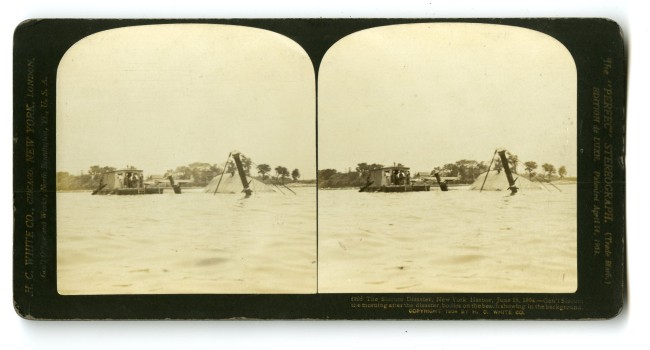
A series of stereoviews was issued by HC White Co. of the aftermath of the disaster. This is 8298. General Slocum the morning after the disaster, bodies on the beach showing in the background.
The General Slocum was an excursion ferry built in 1891 with a rated capacity of three thousand passengers. On June 15, 1904, the ferry was chartered by St. Mark’s Lutheran Church in the East Village. Some 1,358 members of Kleindeutschland (Little Germany), the tightly knit German immigrant community then surrounding Tompkins Square on the Lower East Side, boarded the ferry around nine that morning at a pier on Third Street and the East River. They were bound for an annual picnic at Locust Point in bucolic Huntington on Long Island’s North Shore. Their beloved pastor, Reverend George Haas, and leaders of the church were with them on deck. The Times reported that the General Slocum, which had been recently overhauled, departed with much fanfare that morning. “As she cast off and stood out into the stream her flags were flying, the band was playing a lively air, and her three decks were crowded to their capacity with a happy throng that looked for a pleasant day’s outing at Locust Point, on the Sound.” The majority of passengers were women and children.
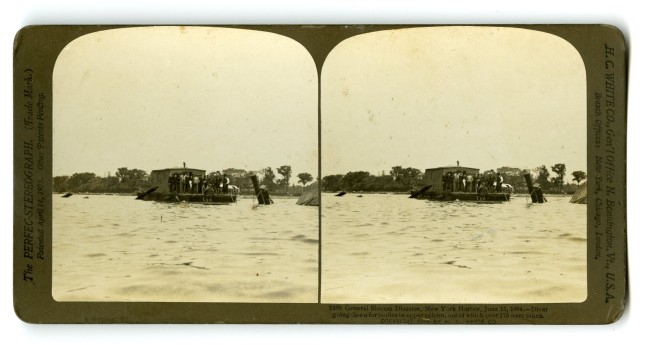
8299. Diver going down for bodies in upper saloon, out of which over 175 were taken.
The captain was William van Schaick, sixty-eight years old and commander of a crew of twenty-three men. He had earlier been cited for having ferried millions of passengers with an unblemished safety record.
8400. The Mass of Burned Timbers and Ruined Metal, showing broken Paddle Wheel Shaft.
Just as the General Slocum was passing Sunken Meadow, adjacent to Randalls Island in the Hell Gate, almost under where the Triborough Bridge spans the river today, cries of “Fire!” broke out below. “It was only a matter of seconds until the entire forward part of the boat was a mass of flames,” the Times reporters continued, and passengers began rushing madly over the three decks to avoid the flames, “All this time full speed ahead was maintained, and the flames, fanned fiercely by the wind, ate their way swiftly toward the hapless women and babies that were crowded on all the decks astern.” The skipper looked out from his pilothouse and saw “a fierce blaze — the wildest I have ever seen.”
8401. Among the Oil Barrels where fire started, showing defective Life Preservers and Life Boats.
“I started to head for One Hundred and Thirty-fourth Street, but was warned off by the captain of a tugboat, who shouted to me that the boat would set fire to the lumber yards and oil tanks there. Besides I knew that the shore was lined with rocks and the boat would founder if I put in there. I then fixed upon NorthBrotherIsland.”
8402. All that was left of the boat which carried over 1000 souls to destruction.
General view of Slocum after being raised.
With fire raging completely out of control and decks already collapsing on terror-struck women and children, Captain Van Schaick, his own clothes on fire, stayed at the wheel and ran the Slocum up on the shore of the hospital island beyond the Hell Gate, but in a part of the river where the current remained extremely swift. As the captain remembered it, “I stuck to my post in the pilothouse until my cap caught fire. We were then about twenty-five feet off NorthBrotherIsland. She went on the beach, bow on, in about twenty-five feet of water. . . . Most of the people aft, where the fire raged fiercest, jumped in when we were in deep water, and were carried away. We had no chance to lower the lifeboats. They were burned before the crew could get at them.”
8403. On the deck of the Slocum, showing the effects of the Fire on Metal Work and Steel.
NorthBrotherIsland became a scene of courage and panic. City Health Commissioner Darlington happened to be on the island that day, visiting the hospital. “I will never be able to forget the scene, the utter horror of it,” he said. “The patients in the contagious wards, especially in the scarlet fever ward, went wild at things they saw from their windows and went screaming and beating at the doors until it took fifty nurses and doctors to quiet them. They were all locked up. Along the beach the boats were carrying in the living and dying and towing in the dead.”
8404. Stern view of the Slocum-What was left of the boat which had on board over 1400 people.
All told, 1,021 perished out of the original 1,358 who boarded the ship that morning. But there were miracles. One little boy was thrown into the river in midstream clutching his stuffed toy dog. He was fished from the river unharmed, still clutching the prized dog. Tales of heroism and cruelty filled the newspaper accounts for days and weeks after the event. A heroic captain ran his tug alongside the General Slocum in full exposure to the fire and saved over a hundred lives. A measles patient from the island hospital ran into the water despite her fever and saved a few children. A nurse who always wished she could swim ran into the river to grab some children, which she did again and again until she was swept into deeper water, where she discovered that she could swim and continued saving lives. Others were antiheros. Crowds of souvenir hunters made collecting bodies difficult in the ensuing days. There were some ghoulish stories of onlookers who stripped bodies of their jewelry. And over and again bystanders described the unconscionable behavior of a private captain who was said to have watched the horror from the safety of a great white motor yacht without ever lifting a finger or launching a boat to assist in the rescues. “Kept His Yacht Back While Scores Perished: White Vessel’s Captain Watched Slocum Horror Through Glasses,” the Times headline stated.
8405. Port view of the General Slocum-The windward side which was burned least.
Still burning at its waterline, the General Slocum was carried off in the current for another thousand yards or so until it struck land at Hunts Point in the Bronx. It remained there, a burnt and partially sunken hull, for the next few weeks. Divers searched for bodies in its sunken remains. Police and rescue parties combed the riverbanks for miles in search of bodies. The Times reported that on the night of June 14, 1904, “grief-crazed crowds” lined the shore where the bodies were being brought in by the boatload: “Scores were prevented from throwing themselves into the river.” Terrible weeks of recrimination, accusation, investigation, and trials followed the disaster. There were reports of rotten life jackets and fire hoses that burst under pressure. Some jackets were found to have been stuffed with metal to give them the regulation weight. The captain and crew were pilloried in the press, as were the ship’s owners. Captain Van Schaick was sentenced to ten years in prison for his part in the disaster but was pardoned four years later by President Taft. Kleindeutchland never recovered. The German settlement moved uptown to what was known as Yorkville, on the East Side overlooking the site of the disaster, and to Astoria in Queens. The burning of the General Slocum was the worst disaster in New York City history until September 11, 2001.
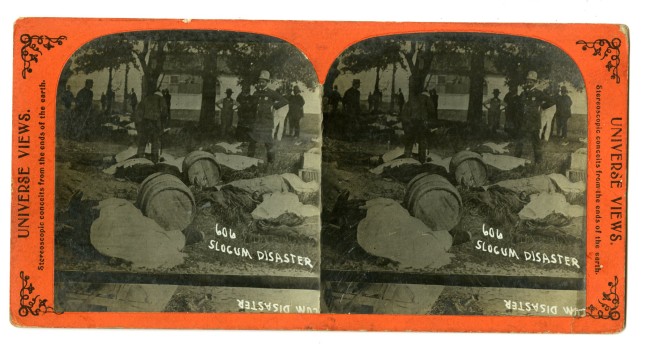
I have two views of the Disaster by “Universe Views: Stereoscopic conceits from the ends of the earth.” They are both numbered 606 and titled Slocum Disaster. The top one has written in the sky of the image “Bodies washed ashore.”
